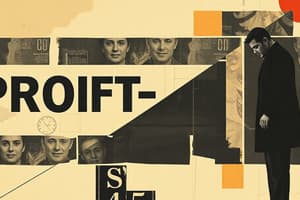Podcast
Questions and Answers
What defines the short run in a business context?
What defines the short run in a business context?
- Businesses can freely expand or contract.
- There is neither entry nor exit from the business. (correct)
- All factors of production are variable.
- Firms can adjust all factors of production.
How does the long run differ from the short run?
How does the long run differ from the short run?
- Firms can only decrease factors of production.
- The long run is a shorter time frame.
- Firms can adjust all factors of production. (correct)
- Long run decisions are irreversible.
What is a production function?
What is a production function?
- It shows the relationship between inputs and outputs. (correct)
- It measures the capital only.
- It describes consumption patterns.
- It predicts market trends.
What does the law of diminishing returns state?
What does the law of diminishing returns state?
Which type of technology relies heavily on human labor?
Which type of technology relies heavily on human labor?
What does marginal product measure?
What does marginal product measure?
Who first formulated the law of diminishing returns?
Who first formulated the law of diminishing returns?
In which scenario is the short run applicable?
In which scenario is the short run applicable?
What is the primary objective of all firms according to the theory of production?
What is the primary objective of all firms according to the theory of production?
Which of the following represents the formula for economic profit?
Which of the following represents the formula for economic profit?
What are out-of-pocket costs also known as?
What are out-of-pocket costs also known as?
What is included in total cost as defined in the theory of production?
What is included in total cost as defined in the theory of production?
What does the normal rate of return represent?
What does the normal rate of return represent?
How does changing the technology of production affect a firm?
How does changing the technology of production affect a firm?
Which decision is NOT one of the basic decisions firms must make to maximize profits?
Which decision is NOT one of the basic decisions firms must make to maximize profits?
What primarily defines total revenue for a firm?
What primarily defines total revenue for a firm?
Flashcards are hidden until you start studying
Study Notes
Profit-Maximizing Firms
- A firm aims to maximize profits.
- Decisions for maximizing profits:
- How much output to supply (quantity of product)
- How to produce the output (which production technique/technology to use)
- How much of each input to demand
- These decisions are interconnected.
- Changing technology alters the relationship between input and output quantities.
Profits and Economic Costs
- Profit = Total Revenue - Total Cost
- Total revenue is the amount received from selling the product (quantity * price).
- Total cost includes out-of-pocket costs and the opportunity cost of factors of production.
- Out-of-pocket costs are explicit or accounting costs.
- Opportunity costs are implicit costs.
- “Profit” from here on refers to economic profit.
- Economic profit = Total revenue - Total economic cost
- Normal rate of return is the rate of return that keeps owners and investors satisfied.
- It's the opportunity cost of capital.
- A rate below normal makes raising resources for new capital difficult.
Short-Run vs. Long-Run Decisions
- Short run: A period with fixed production factors and no exit or entry.
- Long run: A period where firms can expand or contract production factors.
Production Process
- Production: Transforming inputs into outputs.
- Production technology specifies the quantities of inputs needed for a given output.
- Labor-intensive technology relies on human labor.
- Capital-intensive technology relies on capital equipment.
Production Functions
- Production function (or total product function): A mathematical representation of the relationship between inputs and outputs.
- It shows units of total product as a function of units of inputs.
Marginal Product & the Law of Diminishing Returns
- Marginal product: The additional output from hiring one more unit of a specific input, holding all other inputs constant.
- Law of diminishing returns: After a certain point, adding more of a variable input to fixed inputs leads to decreasing marginal product of the variable input.
- Example: Adding more workers to a fixed workspace may lead to decreasing productivity per worker.
Studying That Suits You
Use AI to generate personalized quizzes and flashcards to suit your learning preferences.




